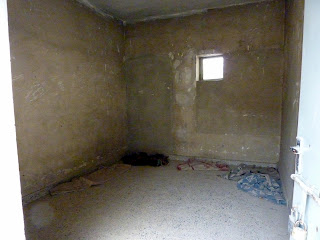*Warning* Entry talks about potential triggers - Rape, Torture. Read with caution.
In many ways, Iraqis are far more fatalistic then Americans.
I was talking to my co-workers the other day about why smoking was so prevalent
here, the answer? “We’re going to die, might as well have a bit of pleasure
before we go.” I’ve heard this attitude over and over again since I have come
here and in many different guises ranging from why horror movies are not that
bad (I’ve seen worse in real life) to my experience s this past weekend. In the
middle of Sulaimaniya is the Red Museum. This building still holds all the
bullet holes and craters from the Kurdish uprising in 1991 and a great deal
more of horrific memories.
 | |
| Kurdish IDPs attempting to escape to Turkey |
A friend of mine and I decided to go together after we had
heard from others that the visit is more than a bit mentally debilitating and I
am ever so glad I did not go alone. We had a very nice tour guide who took us
through the facility. For about 15 years this was the center of imprisonment,
torture and propaganda for the north. Parts of the building have been taken
over for a celebration of Kurdish culture but the majority is left as they were
back during the worst times. The first part of the tour was a representation
done in mirrored glass and lights. 180,000 pieces of mirror for the number of
people killed during Sadaam’s Anfal campaign
against the Kurds and there were 4,500 lights to represent the villages that
were destroyed.
 |
| The mirrored room was commissioned by Hero Talabani - the first lady of Iraq |
We moved on to what was the hardest section for me to get
through. The imprisonment and torture center has been left basically untouched.
We were taken first to the woman’s part. I asked how many would be in there at
one time and was told “As many as would fit”. It really wasn’t a large room at
all. Just four concrete walls with some blankets thrown down. Apparently one
woman was pregnant was she was brought in and gave birth while still
imprisoned. There is a statue of her and her child in the room. Where I had my
first moment of near mind numbing horror was when our guide pointed to the
small room right next to the woman’s quarters and pronounced “This is rape
room.” The nausea started to churn my
stomach then as I stared at this unassuming space imagining the fear of the
women who could hear all that was happening there, knowing that they could be
next.
Already feeling a bit off, I was unprepared for the next
rooms. With a wry twist of his mouth our guide pointed to a room proclaiming it
as “Court”. Evidently being proved innocent was a no go. Around two corners we
were deposited in a dark room lined in wood paneling. After knocking his
knuckles on it, “Sound proofing”, he pointed to a large metal bar with two
hooks. “Torture rack, original model.” As if the tag line mattered at all.
About four feet back from the bar was metal desk that had a metal box on it. Not
sure if I wanted to know the answer, I asked what it was. “Electrical pulses”.
I was right. I didn’t want to know that.
On the other side of the hall was a matching room and just
down the corridor the metal cages of the male quarters bisected a large room.
Just outside of that room in the hallway was a ring disturbingly reminiscent of
what we tied the cows to when we needed them to stay put. After the torture the
victims would be shackled to the wall here for 24 hours, the chain too short
for them to lie down. It left them in full view of the rest of the prisoners.
 | |
| The male imprisonment cages are off to the right of this picture |
In stark contrast to the inside of these buildings, the
grounds were immaculately kept. Trees have grown around the walls providing a pleasant
shade to escape the heat of the day. One of the other buildings has been
converted into a coffee shop. Neatly arranged gravel resides under captured tanks
and anti-aircraft guns while nearby a series of vines have been trained to
provide a cool tunnel of green. We asked the guide if he thinks he will ever
get used to working in such a place. “Never”.
 |
| I just couldn't bring myself to smile |
The Kurds have long memories as evidenced by their continued
irritation at the Brits for the reneging of their promise for a Kurdish
homeland after the breakup of the Ottoman Empire. Ba’athists are still not
allowed to visit the cemetery in Halabjah. Enmity between Arabs and Kurds is
still high. But times are a-changing. Despite the actions of the PKK (either
Kurdish freedom fighters or terrorists depending on who you ask) in Turkey, new
trade deals are being struck and an oil pipeline is planned. Syrians refugees
are being quietly welcomed in the West. The 21st century has stared
the Kurds in the face and they are eager to embrace a new period of peace and
prosperity. What remains to be seen is whether the rest of the world will let
them.


